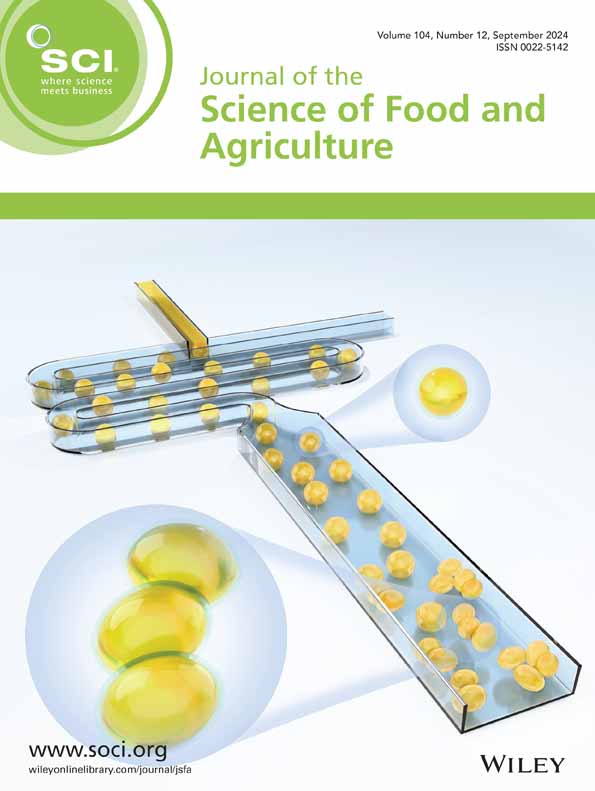Isabela Maria Macedo Simon Sola, Maria Beatriz Macedo Simon Sola, Alessandro Nogueira, Aline Alberti
求助PDF
{"title":"Circular economy opportunities in the yerba mate industry: a review.","authors":"Isabela Maria Macedo Simon Sola, Maria Beatriz Macedo Simon Sola, Alessandro Nogueira, Aline Alberti","doi":"10.1002/jsfa.70224","DOIUrl":null,"url":null,"abstract":"<p><p>Yerba mate (Ilex paraguariensis A. St.-Hil.) is a tree with simple, evergreen leaves, whose infusion, consumed either hot or cold, is widely popular in South America in the forms of chimarrão, tereré and mate tea. Commercially cultivated in Brazil, Argentina and Paraguay, its production reaches thousands of tons annually. The use of yerba mate dates back to pre-Columbian populations, and its popularity increased with the arrival of colonizers who also appreciated its natural properties. The cultivation and industrialization of yerba mate generate byproducts such as fruits, stems and leaves with inappropriate granulometry and post-consumption residues, all of which have significant potential for reuse in various sectors. This study aims to explore sustainable strategies for reusing discarded plant parts to develop value-added products, with a focus on data published over the past decade. These byproducts can be converted into materials such as fertilizers and sustainable packaging. Biorefineries play a critical role in converting these residues into value-added products, such as bioplastics and nanoparticles, using a variety of technologies ranging from biological approaches to thermochemical processes. In the food, pharmaceutical and materials industries, the extraction of bioactive compounds from yerba mate, such as chlorogenic acid and caffeine, enables their application in products ranging from biodegradable films to antioxidant additives. Research and development of technologies to utilize these byproducts promotes innovation and efficient use of resources, highlighting yerba mate as a renewable resource with multiple industrial applications. © 2025 Society of Chemical Industry.</p>","PeriodicalId":17725,"journal":{"name":"Journal of the Science of Food and Agriculture","volume":" ","pages":""},"PeriodicalIF":3.5000,"publicationDate":"2025-09-28","publicationTypes":"Journal Article","fieldsOfStudy":null,"isOpenAccess":false,"openAccessPdf":"","citationCount":"0","resultStr":null,"platform":"Semanticscholar","paperid":null,"PeriodicalName":"Journal of the Science of Food and Agriculture","FirstCategoryId":"97","ListUrlMain":"https://doi.org/10.1002/jsfa.70224","RegionNum":2,"RegionCategory":"农林科学","ArticlePicture":[],"TitleCN":null,"AbstractTextCN":null,"PMCID":null,"EPubDate":"","PubModel":"","JCR":"Q1","JCRName":"AGRICULTURE, MULTIDISCIPLINARY","Score":null,"Total":0}
引用次数: 0
引用
批量引用
Abstract
Yerba mate (Ilex paraguariensis A. St.-Hil.) is a tree with simple, evergreen leaves, whose infusion, consumed either hot or cold, is widely popular in South America in the forms of chimarrão, tereré and mate tea. Commercially cultivated in Brazil, Argentina and Paraguay, its production reaches thousands of tons annually. The use of yerba mate dates back to pre-Columbian populations, and its popularity increased with the arrival of colonizers who also appreciated its natural properties. The cultivation and industrialization of yerba mate generate byproducts such as fruits, stems and leaves with inappropriate granulometry and post-consumption residues, all of which have significant potential for reuse in various sectors. This study aims to explore sustainable strategies for reusing discarded plant parts to develop value-added products, with a focus on data published over the past decade. These byproducts can be converted into materials such as fertilizers and sustainable packaging. Biorefineries play a critical role in converting these residues into value-added products, such as bioplastics and nanoparticles, using a variety of technologies ranging from biological approaches to thermochemical processes. In the food, pharmaceutical and materials industries, the extraction of bioactive compounds from yerba mate, such as chlorogenic acid and caffeine, enables their application in products ranging from biodegradable films to antioxidant additives. Research and development of technologies to utilize these byproducts promotes innovation and efficient use of resources, highlighting yerba mate as a renewable resource with multiple industrial applications. © 2025 Society of Chemical Industry.

 求助内容:
求助内容: 应助结果提醒方式:
应助结果提醒方式:


